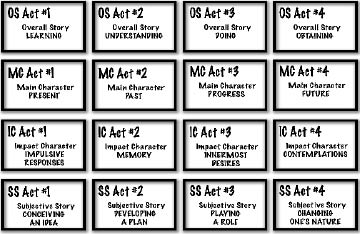Acts & Throughlines
Each throughline has its own four structural acts, which are like the three floors and the roof of our story house. Each of the dynamic acts is like the journey that explores the rooms on one of the three floors. As already discussed, when we choose a Class to be a particular Throughline, the four Types in that Class become the names of the four structural acts. We might write those names on cards and place them in front of us. We can then rearrange those cards to set up an order that reflects the concern with which we want that throughline to begin, the intermediate concerns, and the concern of interest when that throughline ends. Most likely, we will base our decision not only on the logistics of our story, but just as heavily on how this order feels, both to us and we hope to our audience. When we have settled on an order, we can be confident that throughline reflects the proper journey to reach the conclusion we have imagined for it.
If we set up an order for each of the throughlines, we might feel our act level work is done. That would be true if the throughlines were independent. As we already know, however, there is a strong connection between the four throughlines, for each represents only one angle on the same overall story. All four throughlines happen simultaneously, just as the characters in our story house all take the tour at the same time. To truly understand the impact of our decisions for act order, we must lay out all four sets of our cards in parallel rows, side by side, and compare what is happening in the same act in all four throughlines.

As we can see in the illustration above, the flavor of our story as a whole depends both on the order of acts within each throughline and the combination of the acts from all four throughlines. When we lay our plot in this manner, we may elect to make a few changes in one or more throughline's order to more accurately represent the overall concerns of our story's progression as we imagine it.
It is important to remember the order we're talking about reflects only the internal logic of the story, not necessarily the order in which we reveal it to the audience. How we present exposition to the audience is a whole different area of concern covered extensively in Storyweaving. Here we simply want to make sure the act progression in each of the throughlines supports the outcomes, judgments, and conclusions of our story both from a logical and emotional perspective.
Obviously, such considerations must rely heavily on intuition. That is why it is often best to select all the static story points before determining the progressive story points. That extra familiarity with your story will go a long way toward clarifying your intent, providing a more solid foundation for your intuition. In addition, for those who find setting up act order a daunting task, the Dramatica software model is able to calculate the best progression for each throughline's acts, based on your selection of static story points. In this manner, authors who would like some guidance in designing their plots can approach their stories by subject matter and have that input translated into the key stages of plot development and character growth.
